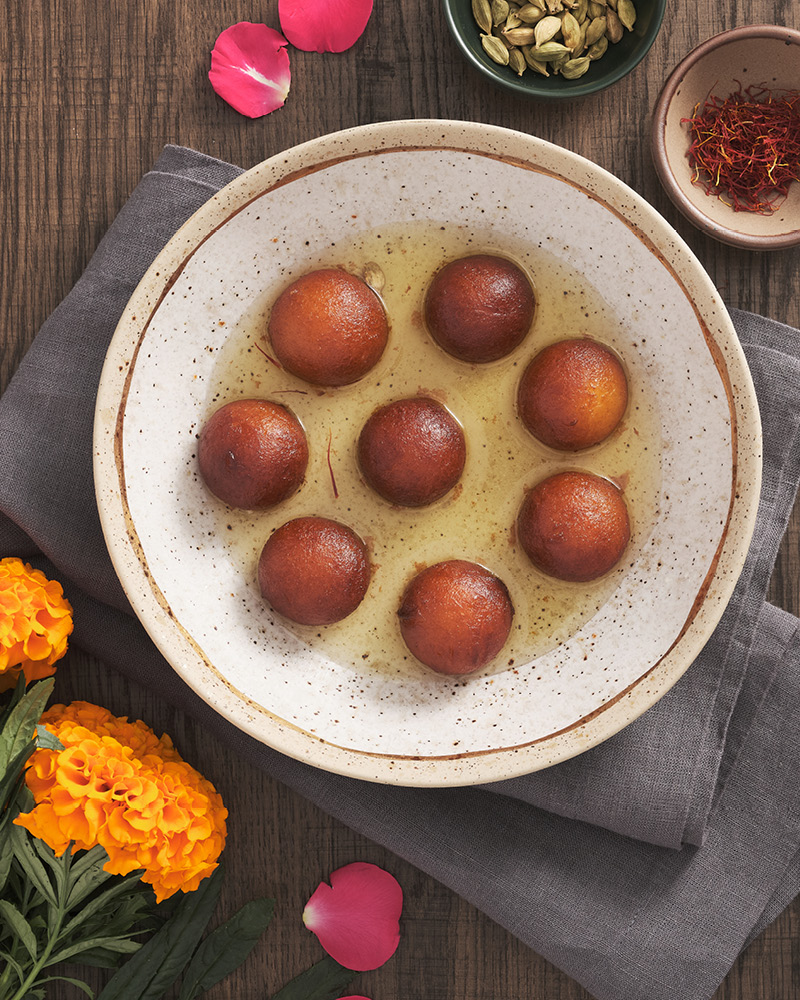
Shri Repp's Gulab Jamun with Milk Powder
MAKES 15
Gulab jamuns are soft, deep-fried, milk-based donuts soaked in a fragrant saffron–cardamom syrup. A true icon of Diwali celebrations! This recipe, created by Shri Repp, uses milk powder for easy shaping and a lightly sweet syrup so you can enjoy them to your heart’s content.
Ingredients
Dough Ingredients
- 1/2 cup (50g) whole milk powder (do not use low-fat)
- 1/3 cup (50g) all-purpose flour
- 1/4 teaspoon baking powder
- 1/8 teaspoon sea salt
- 1 tablespoon ghee or butter melted, plus more to grease your hands
- 1/3 cup (75g) heavy cream
Syrup Ingredients
- 2 cups sugar
- 2 1/2 cups water
- 3-5 cardamom pods (lightly crushed)
- 10-15 saffron strands
- 1/2 teaspoon rose water (optional)
- 1 teaspoon lemon juice
Frying Ingredients
- vegetable oil, enough to fill pot 3 inches deep for frying
- 1/4 cup ghee added to oil for flavor (optional)
Directions
- Note before starting: If you have a scale, this recipe benefits from measuring out everything in grams. Different types of milk powder can have different volume measurements.
- In a large bowl, add milk powder, all-purpose flour, baking powder, and sea salt and mix until dry ingredients are combined.
- Add in ghee, rubbing into dry mixture to form a slightly coarse texture. This step ensures that the dry mixture is coated in fat and will result in a tender jamun.
- Add heavy cream to dry mixture and knead for 1-2 minutes to form a supple dough that has no dry spots and feels similar to play dough. Do not over knead as it can cause a chewier jamun. Cover dough with a damp cloth and let it rest for 5-10 minutes. If dough feels sticky or tacky, add 1 teaspoon of flour until it is no longer sticky. If dough feels hard or tough, add 1 teaspoon of heavy cream until it feels soft like play dough.
- Use a deep, wide pot to prepare syrup. Add sugar, water, cardamom pods, and saffron strands and place on stove on medium heat. Allow syrup to come to a boil, stirring to ensure that sugar dissolves completely. Turn off heat. Mix in rose water and lemon juice. Keep syrup on stove—gulab jamuns will be dunked into syrup once fried.
- Cover syrup with lid to prevent water from evaporating. This is especially important if you are making a large batch of jamuns to ensure that over a prolonged period, the syrup retains the right water to sugar ratio.
- Uncover dough and divide into ~15 pieces, approximately 10 grams each.
- Grease palms of hands with a bit of ghee. Take one piece of dough to work with while covering the others with the damp cloth. Using a little bit of pressure, roll dough in between center of palms until a smooth, non-sticky, round ball is formed with no cracks. Set aside ball under damp cloth and repeat process with remaining dough, remembering to grease hands as needed.
- Use a deep, heavy-bottomed pot for frying. Add ghee and enough oil to fill pot ~3 inches deep. Heat oil to 325° Fahrenheit. Oil can range between 325 and 350° Fahrenheit when frying.
- While waiting for oil to warm up, check temperature of syrup. It should be warm, about 100 to 130° Fahrenheit. If not, turn stove on low to warm syrup up.
- Once oil is hot enough, gently lower in gulab jamuns in batches with a metal slotted spoon.
- Constantly and gently rotate gulab jamuns by creating small waves with slotted spoon to ensure every side is cooked evenly without disturbing the balls. Gulab jamuns should take 3-4 minutes to completely cook and turn golden brown. Make sure oil is not too hot as this will result in the outside browning before the inside is fully cooked.
- Remove gulab jamuns with slotted spoon and add them into warm syrup. Using a different utensil, gently spoon some syrup over top of jamuns to ensure entire ball is coated in syrup. Allow gulab jamuns to soak in syrup for at least 20 minutes, but ideally for 2-3 hours before eating.
- Gulab jamuns can be stored in the fridge with syrup for up to two weeks. They taste best when served warm or room temperature, either by reheating in the microwave or warming on the stove
Cook’s Tips
- Use whole milk powder—NOT low-fat milk powder—for a tender and tasty jamun. If you only have low-fat milk powder, add an additional tablespoon of ghee to the dough.
- If you are looking for detailed tips and tricks or solutions to common gulab jamun mistakes, then check out this Moon Rice blog post.
- If you have extra gulab jamun syrup, don’t throw it out! Filter it if needed and use it in cocktails or mocktails and as a syrup for pancakes or waffles. You can check out this Moon Rice blog post for more ideas on how to use the syrup.
Nutrition
- Calories: 80
- Fat: 5.0 g
- Saturated Fat: 2.5 g
- Trans Fat: 0 g
- Cholesterol: 10.0 mg
- Sodium: 40.0 mg
- Carbohydrates: 7.0 g
- Fiber: 0 g
- Added Sugars: 3.0 g
- Sugar: 4.0 g
- Protein: 1.0 g
